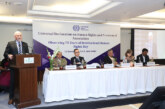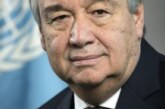
When thirty-eight-year-old Jasmine Shah moved to Delhi in 2013 and found himself engulfed in the city’s toxic winter smog, everything changed for him.
“This scale of air pollution in Delhi, and the fact that it is among the top ten most polluted cities in the world, resulted in my urgent call to tackle the issue,” said Shah.
Targeting public transport seemed like the most logical way to start, with potential for bigger impact than tackling individuals, and Shah began by working with the government, creating momentum for policy change and more electric buses.
From UN Environment, Valentin Foltescu, Senior Programme and Science Officer of the Climate & Clean Air Coalition, added:
“If current policies aimed at reducing air pollution are effectively enforced, air quality will be no worse in 2030 than now, despite population growth, rapid urbanization and an ever-increasing demand for goods and services, but neither will air quality be better.
“What do we need then to make the air breathable amid rapid economic development? We must move quickly to low and zero emissions solutions and comprehensive transformations. We should aim for full electrification of sectors in combination with clean energy.”
Today, as Vice Chairperson of the Dialogue and Development Commission of Delhi, an internal think tank of the Delhi government, we asked Shah what advice he has for young people interested in working alongside government towards effective policy change.
What inspired you to tackle air pollution?
A couple of winters in Delhi brought me face to face with the toxic smog that engulfs Delhi during this period. I realized that we needed more long-term measures to tackle air pollution since what we have is a health emergency in India. Particulate matter—hazardous pollution particles suspended in the air—is highly concentrated in most Indian cities and nearly 10–15 times the World Health Organization’s safety limits. And unfortunately, the problem disproportionately affects children and the elderly. Something had to be done.
What inspired you to get involved in the transport industry specifically?
The city of Delhi is well devoted to tackling air pollution and the government had already prioritized this issue on their agenda. In 2016, Delhi became the first city in India to launch a very successful Odd-Even scheme as an emergency measure to restrict the movement of private vehicles on polluted days. But since the transport sector is a top contributor to particulate emissions, I was motivated to look for long-term solutions. In February 2018, I advised the Delhi government in preparation of a comprehensive Green Budget—a 26-point long-term action plan to tackle air pollution in Delhi, with a major focus on the transport sector. Two of the most important initiatives in this were the introduction of 1,000 electric buses in Delhi and a comprehensive electric vehicle policy.
What challenges have you faced in introducing electric buses to Delhi?
With the political will already in place, the challenges we faced in Delhi were largely infrastructural and operational. We had to undertake a detailed study of the city and its transport networks before planning the electric bus routes. We undertook site visits to China to learn from best practices, since no other city outside of China has committed to bringing such a large number of electric buses. I am happy to say that we have already initiated procurement of 385 e-buses for Delhi, which should arrive by November. By 2020, we aim to bring in 1,000 e-buses.
What is your advice to youth interested to inspire change through policy action?
I encourage all young people to be persistent, creative and innovative. We have the know-how to beat air pollution. Build networks and connect with relevant people whose vision aligns with yours, and together we can combat air pollution. I believe this is achievable but requires patience and hard work.
What is your hope for the future in terms of tackling air pollution?
Air pollution is a complex problem. There are various sources of pollutants—dust, transport, industrial emissions. A comprehensive set of strategies is required to tackle the problem, and our vision for the future in Delhi is to work on all of these. In the transport sector, we are taking many steps to work towards a zero-carbon city and to ensure 25 per cent of all new vehicles in Delhi are electric by 2024. We are developing more pedestrian walkways and cycle lanes in the city to encourage walking and cycling. My vision for the future of India is to see the political leadership at national level fully acknowledge air pollution as a health emergency and act upon it. There are many solutions to tackle air pollution but we need political commitment and specific budgets and action plans to address this rising health issue.
Air pollution is the theme for World Environment Day on 5 June 2019 hosted by China. The quality of the air we breathe depends on the lifestyle choices we make every day. Learn more about how air pollution affects you, and what is being done to clean the air. What are you doing to reduce your emissions footprint and #BeatAirPollution?
The 2019 World Environment Day is hosted by China.



